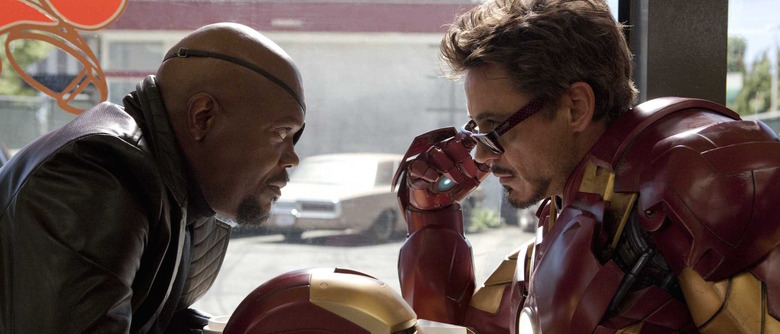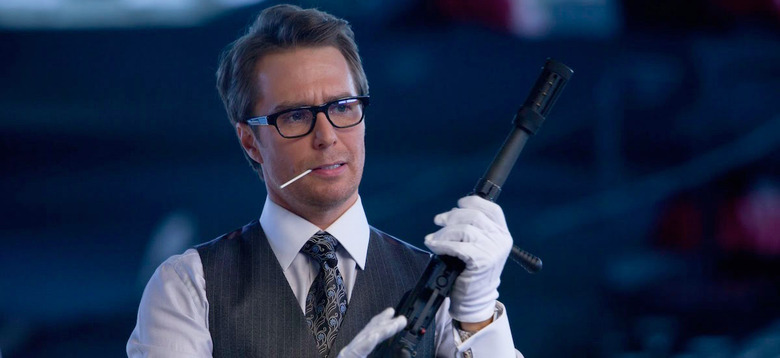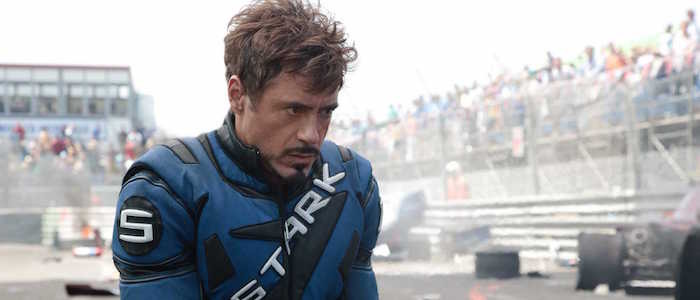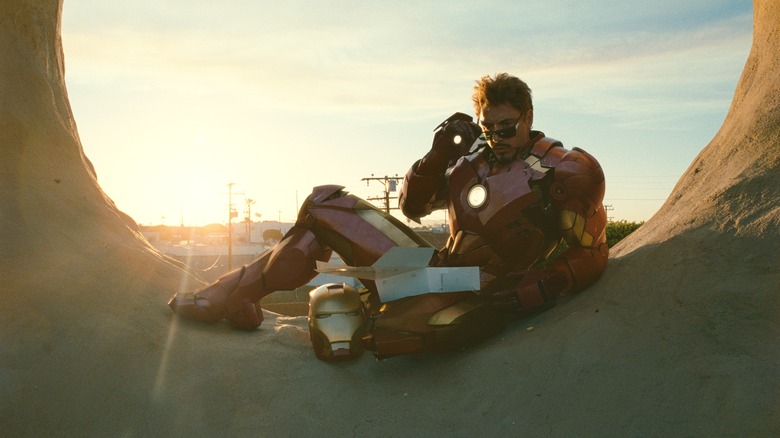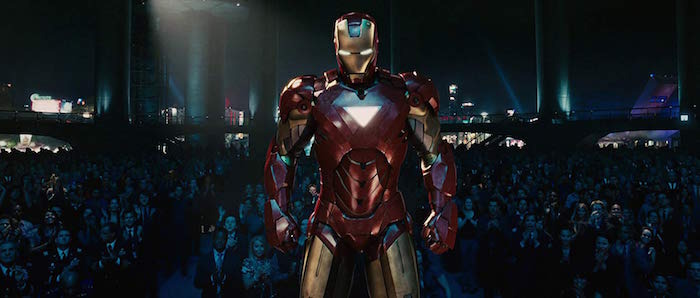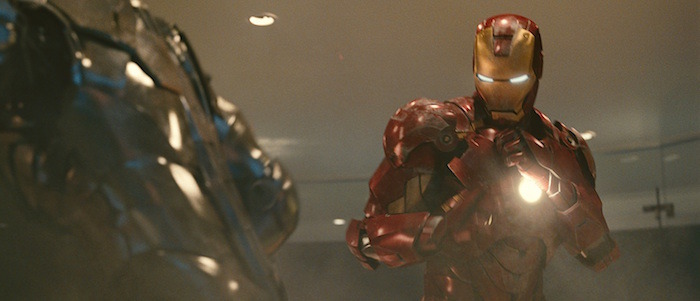Road To Endgame: 'Iron Man 2' Was The MCU's First Major Misfire
(Welcome to Road to Endgame, where we revisit all 22 movies of the Marvel Cinematic Universe and ask, "How did we get here?" In this edition: Marvel drops the ball with Iron Man 2.)Iron Man 2 is "fine," in the most middle-of-the-road, passive-watch sense. The descriptor feels apt, since the film features neither the novel spark of its predecessor, nor the emotional highs of Marvel's future installments. Truth be told, it doesn't have enough by way of narrative risks to be a memorable failure either. However, it helped further cement Tony Stark and Robert Downey Jr. as key fixtures of popular culture.Even as a feat of world-building, Iron Man 2 does little to expand on previous films. But more pertinently, it's emblematic of why the early Marvel movies had such a muddled approach to politics. Like Iron Man before it, the film's military funding doesn't just result in a wrongheaded political outlook, but in a confused character-story, thrown further off balance by the need to juggle popcorn entertainment, sequel setups and a world where, once again, private industry and hostile foreign forces bear all the responsibility of war.
A Propaganda Sequel
Like its Pentagon-funded predecessor, Iron Man 2 is divorced from anything resembling political reality. It's the second of Marvel's films made with military assistance — Captain America: The Winter Soldier came next, followed by Captain Marvel — and it falls back on Iron Man's problem of constantly deflecting the blame for global conflict away from the U.S. military. This framing, while questionable in and of itself, has ripple-effects for the story the film thinks it's telling.Both Iron Man films were made with military subsidies — in this case, equipment and locations were insured for $20 million — so the Department of Defense was granted final script approval. (You can download the film's D.O.D. production agreement here, obtained via SpyCulture under the Freedom of Information Act).During the film's prologue, we're shown a brief newspaper snippet with the headline "Iron Man Stabilizes East-West Relations," before Tony Stark shows up to his eponymous Expo (see: eXpo). He calls the preceding six months "the longest period of uninterrupted peace the world has ever seen," which, apart from being a lazy narrative assertion without further clarity, happens to clash directly with the film's own story.Iron Man 2 is set into motion when the U.S. government subpoenas Tony Stark to appear in front of an arms committee... Well, no, it's actually set into motion when Ivan Vanko (Mickey Rourke), the son of Anton Vanko, a man wronged by Stark's father, crashes Stark's reckless Grand Prix stint... Actually, it's hard to be certain of which incident has more impact on the plot, given that one is exposition with no story momentum, and the other is an action scene divorced from character. Either way, Iron Man 2 feels like two separate films at first — and by the end, for that matter.While the committee hearing establishes Stark's relationship to his creation ("I am Iron Man. The suit and I are one."), much of it is spent re-establishing the specifics of this so-called world at peace, a global armistice brought about by one man. At the hearing, not only are we introduced to private weapons manufacturer Justin Hammer (Sam Rockwell), we're also given glimpses into the comically ineffectual — though most certainly active — military R&D of nations like Iran and North Korea, whose own Iron Man projects are being developed by Hammer. These countries aren't framed as real threats, despite their militaries being supplied by the same weapons manufacturer as America.The world is in an arm's race to create its own Iron Men. Col. James Rhodes (Don Cheadle), the future War Machine, wants these weapons for the United States, while antagonist Justin Hammer seeks to build them for whoever can line his pockets. Just like the first Iron Man, the villains of this political climate are anyone who would use these weapons against America, even if America is just as, if not more likely to use them first. Like Obadiah Stane (Jeff Bridges) before him, Hammer is only a villain because of his double-dealing, while Rhodes is a hero despite buying from Hammer. Rhodes' War Machine armour was even partially designed by the U.S. Air Force (per the Pentagon's Hollywood database, also obtained via SpyCulture), in order to "meticulously and accurately reflect realistic aircraft markings."
A World At War
Per the video footage seen in the film — displayed by Stark himself, no less — this is far from a world at peace, regardless of how many times Stark calls himself a "nuclear deterrent." It is, at best, a world locked in a global Cold War, even though assertions of worldwide armistice come from "objective" narrative sources (news clippings and the likes) outside the protagonist's viewpoint. The world of the film is exactly as Tony Stark sees it, so his outlook is rarely challenged, a problem that's exacerbated when his father's questionable legacy comes into play.In a better film, one might be given reasons for the discrepancy between claims of peace and continued private militarization. An industry thriving on conflict would be unlikely to let the conflict end (Iron Man and Iron Man 3 even touch on this dynamic), but Iron Man 2 simply zips past its own premise, creating a narrative disconnect.The villains' plot involves Justin Hammer recruiting Ivan Vanko to create Iron Man-esque suits (and later, drones) for the U.S. military. It's a direct and logical escalation of the first film, which focused on private arms manufacture and underhanded dealings. The sequel however, is less concerned with what suit or drone warfare would mean (for America, and for Stark) in terms of responsibility, and more intent on having Stark talk about how he "privatized world peace," without exploring how these two ideas might come into conflict. Besides, Hammer's American military drones are only framed as a threat when they're controlled by an evil foreigner.In a story in which global militaries are still active (and still an active threat to Iron Man), one would hope someone — or some action or event — would challenge Stark's view on peace, at least for the sake of dramatic conflict. Then again, America stockpiling weapons being conflated with a peaceful status quo is par for the course for military propaganda. "Peace means having a bigger stick than the other guy," and all that.Despite the characters paying lip service to peace, the world is exactly as it was during the events of Iron Man six months prior. We're never told or shown anything Stark has done to actually change things. This would require treating the Marvel Cinematic Universe as something resembling the real world — a world in which Iron Man would need to oppose American militarism and foreign occupation in order to achieve a peaceful outcome.In lieu of a challenging narrative, we're instead presented with a movie in which Tony Stark watches movies.
Starks in Stasis
Iron Man 2's entire second act features both its hero, Tony Stark, and its villain, Ivan Vanko, under house arrest. The two men, now mirrors to each other, are said to be defined by fathers' legacies. The film opens with Vanko's father dying in poverty, having been deported by Howard Stark decades earlier. Later in the film, Tony Stark mentions his own father never having loved him as a child. However, these circumstances never manifest in the form of either characters' actions, let alone their ethos. Stark's motivation is disconnected from anything pertaining to his father Howard, a ghost he watches on film and a man who ought to be the linchpin for this entire conflict. Vanko even calls Stark's family "thieves and butchers" who rewrote their own history. But Stark's story, from this point on, only involves realizing his father believed in him all along, which impacts neither what he does, nor what he believes.Similarly, Vanko's plan, despite his talk of making Gods bleed so people can see who they truly are, never actually involves changing anyone's view of Stark or his family. Justin Hammer even conspires with Vanko to "go after [Stark's] legacy" but this exchange is rendered meaningless.What ought to have been a mirror to (and an extension of) the first film, in which Stark is forced to face his past, instead becomes a story where interpersonal drama is both delayed and diluted. Despite talking explicitly about destroying the Stark name, Vanko simply continues building his own suit in the hopes of fighting Stark. There's no external perspective — that of the public, or any other character — to represent how the world sees Stark or his family. Vanko's weapons mirror Iron Man's tech, but nothing Vanko does ever challenges Tony Stark as a character.
Stark, the Living Dead
Tony Stark's biggest battle in Iron Man 2 is accepting his own mortality, a challenge that presents itself when the arc reactor keeping him alive begins to poison him from within. This question of mortality could have made for an interesting contrast with his perceived Godhood; he did bring about world peace, after all, and people worship him for it.Of course, a story trajectory such as this would have required shining a light on how exactly he changed the world. But the film makes sure to avoid political specifics at all cost, a likely outcome of its script having to be military-approved.Instead, Stark's battle with mortality is dramatized through his juvenile behaviour. He throws lavish parties, pees in his suit, and endangers his guests by shooting lasers at watermelons, a fun sequence that seems like it might to lead to Rhodes reining him in. However, this subplot is cut short just a few minutes later. Rhodes — who oscillates between being shocked that the military wants weaponized suits, and excitedly weaponizing these suits himself — simply absconds with Stark's extra armour instead of helping his dying friend, something he learned of just a few scenes prior.An hour into the film, this through-line of Stark dying at the hands of his tech is thrown out the window, when S.H.I.E.L.D. agents Nick Fury (Samuel L. Jackson) and Black Widow (Scarlett Johansson) come around for some pre-Avengers setup. They provide Stark with a slick antidote, circumventing any need for him to confront his own reckless actions, at which point they introduce Stark's conflict with his father. Rather than augmenting the story of Stark facing his mortality, the celluloid ghost of Howard Stark simply replaces it.Thanks to a quick injection from Black Widow, the poison clogging up Stark's system instantly subsides. His veins suddenly cease to take on a mechanical appearance. The symbolism could not be more perfect: the intruding shared-universe erases the most potent visualization of Stark being his own worst enemy, robbing the film of any real dramatic challenge. Problem solved.
Iron Man the Science Guy
I like my made-up comicbook science as much as the next guy, but it's something Iron Man 2 botches severely. Tony Stark finds the map to a new element hidden in Expo plans left to him by his father, a man who had trouble showing his love, but a man whose secret belief in Stark now remains through his work. It's the kind of pseudo-scientific soap opera I can get on board with — or rather I would, were it grounded in a discernibly human story.As Stark rummages through old belongings, he finds a confession from his father, one that has little bearing on either man in the long run. Howard's secret love for his son adds a nice texture to Stark's story, but their supposed disconnect never manifests in either Iron Man film. Stark's arrogance was never framed as stemming from paternal insecurities, nor is it framed as such from this point forward. Doubting his own abilities was never a problem for Stark either, so the reveal that his father secretly believed in him is a solution to non-existent problem.Stark discovering this new element simply happens to coincide with the discovery of his father's true nature. It's only half a story, playing lip-service to a potentially complex tale of Stark having to contend with his father's secret love alongside his secret crimes.Howard having deported Anton Vanko plays even more villainously in 2019, and his involvement in creating the Atom Bomb doesn't even come up as it did before. Instead, all we truly learn about Howard Stark is that he helped found S.H.I.E.L.D., an organization whose sole purpose in this film is connecting it to the rest of the series.Tony Stark being an innovator was central to Iron Man, in which he began using his tech in new ways after his change of heart. In Iron Man 2, his innovations are either in service of actions scenes that feel cut short, or in service of continuing Howard Stark's work without contending with either of his hidden natures — as a loving father or as a mass murderer. Remove all of Ivan Vanko's dialogue from the film, in which he talks about Stark's murderous legacy, and the story remains the same.Iron Man ends up fighting "bigger Iron Man" once more, but unlike Iron Monger in the first film, this bastardization of Stark's tech represents nothing for the characters and what they believe. "Bigger Iron Man" just happens to have whips now. It's the nothing-est of the handful of nothing Marvel films. And yet, it succeeds in one very key area that stops it from being a complete disaster.
Saved By Performance
The Tony Stark of Iron Man (2008) leads directly into the Tony Stark of The Avengers (2012) and Iron Man 3 (2013). The rest of the saga— films like Avengers: Age of Ultron (2015), Captain America: Civil War (2016) and even Spider-Man: Homecoming (2017) — retroactively re-frames gaps in the series' political approach as mistakes made by Stark himself. The janky detour that is Iron Man 2 has little by way of character development, but its strong performance from Robert Downey Jr. carries it over the finish line, establishing a character that fits perfectly into this ever-shifting continuum.Iron Man 2, perhaps inadvertently, plants seeds for ideas that would eventually be explored. The theme of contending with one's legacy is a central part of Stark's story (and of all the Avengers' stories) later in the series, while Stark's views on his mortality eventually come to the fore. Even the film's half-baked ideas about private vs. military security would become a central focus. Iron Man 2 ought to feel like an outlier for failing to properly establish these narratives, but it remains a fascinating piece of the puzzle in retrospect thanks to its lead performance.Robert Downey Jr. is an expert at delivering dry quips, but he shoulders even these half-formed ideas with finesse. There are tales of legacy and mortality hidden somewhere beneath the mess that is Iron Man 2; Downey Jr. embodies them in ways that allow for the Tony Stark of future films to expand on. This Tony Stark, who eventually deals with complicated questions of power, legacy and his own place in the world, is born during Downey Jr.s' closeups in Iron Man 2, as Stark reflects silently on his own history.As much as Stark watching old home movies has no bearing on how he changes, Robert Downey Jr. internalizes all these half-formed ideas — mourning, reflecting and contemplating, rather than his usual joking M.O. — thus cementing Marvel's greatest strengths, even in its weakest film. Whatever the Marvel movies' flaws, and they are numerous, at least they've never gone wrong with casting.
***
Expanded from an article published April 4, 2018.

